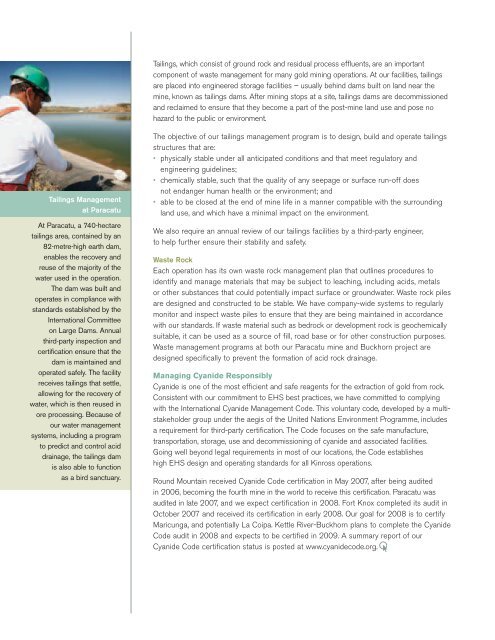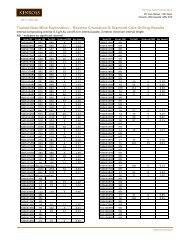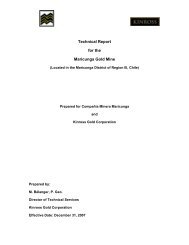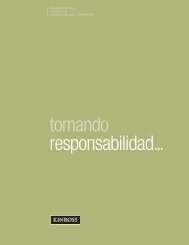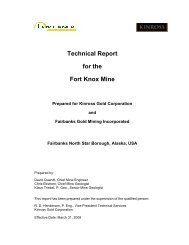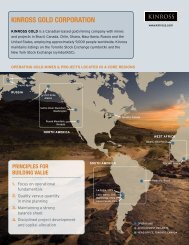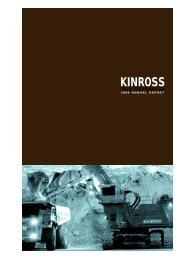2007 Full Report - Kinross Gold
2007 Full Report - Kinross Gold
2007 Full Report - Kinross Gold
Create successful ePaper yourself
Turn your PDF publications into a flip-book with our unique Google optimized e-Paper software.
Tailings, which consist of ground rock and residual process effluents, are an importantcomponent of waste management for many gold mining operations. At our facilities, tailingsare placed into engineered storage facilities – usually behind dams built on land near themine, known as tailings dams. After mining stops at a site, tailings dams are decommissionedand reclaimed to ensure that they become a part of the post-mine land use and pose nohazard to the public or environment.Tailings Managementat ParacatuAt Paracatu, a 740-hectaretailings area, contained by an82-metre-high earth dam,enables the recovery andreuse of the majority of thewater used in the operation.The dam was built andoperates in compliance withstandards established by theInternational Committeeon Large Dams. Annualthird-party inspection andcertification ensure that thedam is maintained andoperated safely. The facilityreceives tailings that settle,allowing for the recovery ofwater, which is then reused inore processing. Because ofour water managementsystems, including a programto predict and control aciddrainage, the tailings damis also able to functionas a bird sanctuary.The objective of our tailings management program is to design, build and operate tailingsstructures that are:• physically stable under all anticipated conditions and that meet regulatory andengineering guidelines;• chemically stable, such that the quality of any seepage or surface run-off doesnot endanger human health or the environment; and• able to be closed at the end of mine life in a manner compatible with the surroundingland use, and which have a minimal impact on the environment.We also require an annual review of our tailings facilities by a third-party engineer,to help further ensure their stability and safety.Waste RockEach operation has its own waste rock management plan that outlines procedures toidentify and manage materials that may be subject to leaching, including acids, metalsor other substances that could potentially impact surface or groundwater. Waste rock pilesare designed and constructed to be stable. We have company-wide systems to regularlymonitor and inspect waste piles to ensure that they are being maintained in accordancewith our standards. If waste material such as bedrock or development rock is geochemicallysuitable, it can be used as a source of fill, road base or for other construction purposes.Waste management programs at both our Paracatu mine and Buckhorn project aredesigned specifically to prevent the formation of acid rock drainage.Managing Cyanide ResponsiblyCyanide is one of the most efficient and safe reagents for the extraction of gold from rock.Consistent with our commitment to EHS best practices, we have committed to complyingwith the International Cyanide Management Code. This voluntary code, developed by a multistakeholdergroup under the aegis of the United Nations Environment Programme, includesa requirement for third-party certification. The Code focuses on the safe manufacture,transportation, storage, use and decommissioning of cyanide and associated facilities.Going well beyond legal requirements in most of our locations, the Code establisheshigh EHS design and operating standards for all <strong>Kinross</strong> operations.Round Mountain received Cyanide Code certification in May <strong>2007</strong>, after being auditedin 2006, becoming the fourth mine in the world to receive this certification. Paracatu wasaudited in late <strong>2007</strong>, and we expect certification in 2008. Fort Knox completed its audit inOctober <strong>2007</strong> and received its certification in early 2008. Our goal for 2008 is to certifyMaricunga, and potentially La Coipa. Kettle River-Buckhorn plans to complete the CyanideCode audit in 2008 and expects to be certified in 2009. A summary report of ourCyanide Code certification status is posted at www.cyanidecode.org.


